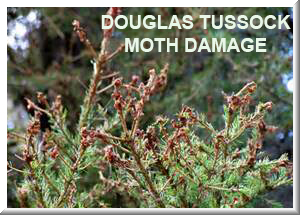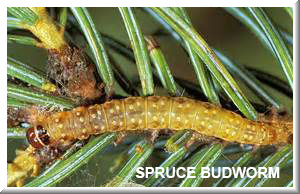![]()
Douglas-Fir Tussock Moth (Orgyia pseudotsugata) and Spruce Budworm (Choristoneura hebenstreitella)
Populations of these two defoliating caterpillars continue to expand this year in the Colorado Springs area. Blue Spruce, Douglas Fir and White Fir are hosts to these insects. Larvae were observed hatching in early June and evidence of feeding on new growth is just starting to show up.
 The caterpillars of both moths feed on the new needles, eventually moving on to older needles and stripping the branches. After the initial season of feeding, a tree can usually put out new growth the following year, but with repeated defoliation a tree will die or become prone to bark beetles. It is important to spray for these insects. Chemical controls should be applied shortly after egg hatch in May or early June but can be applied into July if the caterpillar is still on the tree. A biological option, Bacillus thuringiensis, is also available and effective for early instar stages of the caterpillar. It is a bacterium that feeds on caterpillars. Timing is critical and it is not as effective as other control options.
The caterpillars of both moths feed on the new needles, eventually moving on to older needles and stripping the branches. After the initial season of feeding, a tree can usually put out new growth the following year, but with repeated defoliation a tree will die or become prone to bark beetles. It is important to spray for these insects. Chemical controls should be applied shortly after egg hatch in May or early June but can be applied into July if the caterpillar is still on the tree. A biological option, Bacillus thuringiensis, is also available and effective for early instar stages of the caterpillar. It is a bacterium that feeds on caterpillars. Timing is critical and it is not as effective as other control options.
 Douglas-Fir tussock moth has been most prevalent in our landscape trees but is also in forested areas on Cheyenne Mountain and on Rampart Range Road. Spruce budworm has surged in forested areas such as Cheyenne Cañon, Cheyenne Mountain and along Rampart Range Road. It can also move into our landscape Spruce and Fir trees.
Douglas-Fir tussock moth has been most prevalent in our landscape trees but is also in forested areas on Cheyenne Mountain and on Rampart Range Road. Spruce budworm has surged in forested areas such as Cheyenne Cañon, Cheyenne Mountain and along Rampart Range Road. It can also move into our landscape Spruce and Fir trees.